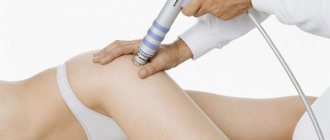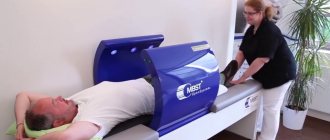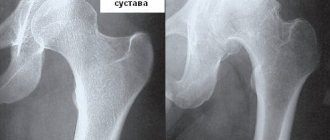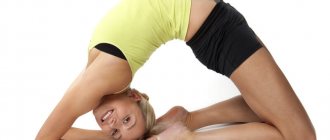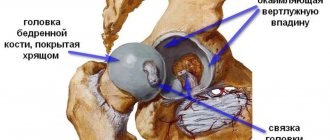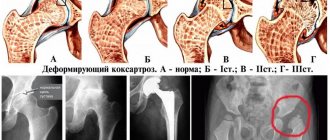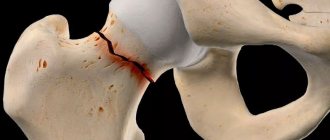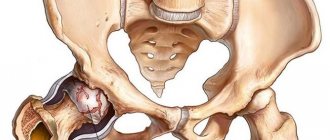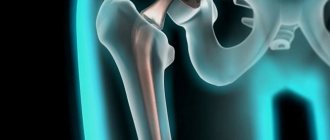Osteoarthritis of the hip joint is a serious progressive disease that, if not adequately treated, leads to disability. Cartilage and bone tissue are destroyed, joints rub and cause severe pain. Unfortunately, these processes often occur against the background of natural aging of the body and are detected too late. However, today coxarthrosis is also diagnosed in young people.
In the initial stages, treatment of osteoarthritis of the hip joint is possible using conservative methods. The regimen includes medications, rest, proper nutrition, physiotherapy and, of course, physical activity. We bring to your attention an effective simple set of five exercises, designed specifically for people with this diagnosis.
Do these exercises 2 times a day - and live a full life
№ 1
Take a position lying on your stomach, place your legs hip-width apart. Hands in front of you, lower your head onto the backs of your hands with your chin.
As you inhale, lift your straight leg up, and as you exhale, gently lower it to the floor. Repeat for the other leg. The movements should be dynamic, but not too sharp - 15-20 for each leg. After this warm-up, lift your leg off the floor and hold it there for 15-30 seconds.
When performing this exercise, it is important that your leg is straight. It is advisable to raise it as high as possible, but the main thing is to prevent pain in the hip area.
Treatment with gymnastics according to Bubnovsky
Professor S. M. Bubnovsky has developed an effective method for treating coxarthrosis, which allows one to avoid surgery and restore quality of life. The technique is known under the term “kinesitherapy” and is based on the treatment of joints with movement.
The complex includes the following exercises:
- Get into a knee-elbow position. As you inhale, slowly arch your back, while exhaling, bend your back. Exercise relaxes your back.
- Leaning on your palms and knees, stretch forward, without bending in the lumbar region. Return to previous position.
- Leaning on your elbows, exhale and lower yourself to the floor. Straighten your arms on the next exhalation, lowering your buttocks to your heels.
- Change position - roll over and lie on your back, as for pumping your abdominal muscles. Reach your elbows to your knees. In the same position, raise the pelvis as high as possible.
Bubnovsky exercises are performed for 10-30 repetitions, if possible, taking into account the general condition.
№ 2
The starting position differs from the previous one only in that the legs are bent at the knees so that the feet look up at the ceiling.
As you inhale, push your foot up, and as you exhale, lower it to the floor. Repeat for the other leg, and then 15-20 dynamic movements for each. When finished, also raise your leg above the floor and hold it, without pain, for 15-20 seconds on weight.
It is very important that the leg is bent at the knee 90°. The second rule is not to make it painful, otherwise such exercises for arthrosis can cause harm.
The main rule is no movement through force and pain.
Features of the pathology
Symptoms of coxarthrosis:
- lameness;
- soreness in the thigh;
- discomfort;
- feeling of tightness;
- unpleasant crunching sounds in a joint.
The head of the hip joint with coxarthrosis of the 3rd degree. Pay attention to the poor condition the surface is in - it should be perfectly smooth.
Degrees of coxarthrosis and their characteristic signs:
| Degree of disease | Symptoms of pathology that may be observed in a patient |
| 1st degree | Pain in the leg that develops after straining the joint. During diagnosis, minor joint defects can already be noticed |
| 2nd degree | Increased pain, which begins to radiate to the lower leg area. With each passing month, the joint becomes disrupted, lameness develops, and a characteristic crunching sound appears when walking. Shortening of the limb is possible due to distortion in the pelvic bones. The photographs clearly show an upward displacement of the head of the joint. |
| 3rd degree | The development of constant pain that bothers a person even at night. Specific crooked gait. Severe movement disorder, spasmodic pain when starting to walk. An x-ray shows how the head of the joint is severely affected. There are many defects localized on it |
Pain with coxarthrosis can radiate both lower to the limb and higher along the spine - depending on the type of gait you have.
№ 3
Take a position lying on your right side, place your right hand under your head, and with your left hand rest your palm on the floor in front of you. The right leg should be bent at the knee with the foot placed behind the back. Place your left leg straight, in line with your body.
As you inhale, lift your straight left leg up, and as you exit, lower it to the floor. Repeat the movement 15-20 times. Then lift your leg up and hold it for 15-20 seconds. Turn over to the other side and perform the same steps.
The leg you lift should be straight at the knee. Use your other leg and arm to maintain support. The doctor who prescribed treatment for arthrosis can adjust the degree of stress.
Causes of the disease
Before considering the main effective exercises for coxarthrosis, we will indicate the causes of coxarthrosis:
- Joint damage.
- Curvature of the spine in an advanced form.
- Dysplasia.
- Metabolism problems, poor blood circulation.
- Severe physical activity.
- Hormonal imbalances.
- Chronic state of stress.
Often coxartosis is a consequence of another problem: for example, with the spine. First of all, you need to treat it.
People who lead a sedentary lifestyle, athletes, patients suffering from severe chronic pathologies, and close relatives of people with coxarthrosis are susceptible to the disease.
Women are susceptible to coxarthrosis, or osteoarthritis of the hip joint, due to the structural features of their joints. The disease can affect either one or both joints at once, leading to a rapid loss of the ability to move normally.
№ 4
The exercise is performed in an identical position as the previous one, only with both legs bent at the knees and the feet behind the back.
As you inhale, lift your left leg up, and as you exhale, lower it down. Perform 15-20 dynamic actions again, then lift the same leg and hold it on weight for 15-20 seconds. Repeat for the second side.
The leg in motion should remain at a 90° angle at the knee.
Avoid jerking and sudden movements
Preventive measures
To reduce the risk of developing coxarthrosis, follow these medical tips for preventing the disease:
- to refuse from bad habits;
- enrich the menu with products containing calcium;
- avoid stress;
- promptly treat abnormalities that may subsequently lead to coxarthrosis;
- be physically active;
- do not put increased loads on the joint;
- If any discomfort occurs, immediately visit a specialist;
- regularly practice preventive exercise;
- engage in light sports.
Lose weight urgently, lose weight at any cost!
№ 5
Lie on your back, bend your knees, bringing them as close to your stomach as possible. Place your palms on your knees.
Using your hands, slowly rotate your knees in a circle - 15-20 rotations clockwise and then counterclockwise. It is very important to avoid jerking, and if your physical fitness allows, you can gradually increase the range of movements.
It is advisable to pre-coordinate physical activity with your doctor, and also undergo diagnostic testing the day before. The orthopedist will adjust the exercises, add other movements to the gymnastics and give other advice. In some cases, such activity is contraindicated, for example, if arthrosis has already seriously progressed.
For those who do not have arthrosis, it would also be a good idea to take care of the hip joint. You can, for example, perform this exercise “for the lazy” - for relaxation:
With stages 2-3 of coxarthrosis, a person often experiences pain with the slightest movements, so, first of all, this problem needs to be solved. Intra-articular injections of a synovial fluid substitute, a liquid endoprosthesis, for example, Noltrex, Fermatron, Sinokrom, will help. The product will be evenly distributed inside the joint capsule, will move apart the worn surfaces and stop the pain. After this, for preventive purposes, to improve blood circulation in the joint, you can begin a set of exercises - of course, without fanaticism!
Diagnostics
Diagnosis of joint coxarthrosis is carried out on the basis of an X-ray examination and study of the clinical picture. During the examination, the doctor observes limited mobility of the joints or their deformation. In more advanced stages, there are signs of shortening of the limbs and atrophy of muscle tissue. The patient complains of pain that increases with palpation. To confirm the diagnosis, the patient is prescribed one or more instrumental research methods:
- X-ray - it is used to determine the degree of arthrosis and its characteristic signs;
- Ultrasound is the advantage of this research method in the absence of radiation exposure to the patient’s body;
- MRI - allows you to really assess the condition of cartilage tissue and clearly visualize the affected areas;
It is not difficult for a qualified specialist to identify arthrosis of the hip joint. But for an objective assessment of the clinical picture, he should take into account the possible secondary origin of the disease. It is likely that the pathology resulted from another disorder.
Additional features of Artromot Active
Thanks to the design features of the Arthromot device, it can be used not only for rehabilitation after prosthetics, but also as a preventive measure aimed at preventing knee stiffness. Treatment using mechanotherapy is painless, which improves the patient’s comfort and well-being.
There is only a minimum list of contraindications for the use of Artromot; the device is suitable for the rehabilitation of children from 6 years of age. The traumatologist and rheumatologists of the Artus Clinic will select a convenient schedule of visits for the patient and use suitable simulator options to reduce the recovery period to a minimum.
The benefits of exercise therapy for coxarthrosis
Physical activity and gymnastics for coxarthrosis of the hip joint can slow down the progression of the disease and alleviate its symptoms, as well as delay the onset of severe dysfunction.
The right exercise therapy program will help:
- Reduce pain. Exercises in combination with manual therapy, massage, physiotherapy and other methods help relieve pain.
- Improve mobility. A physical therapy doctor can develop an individual program, with the help of which many patients manage to restore the range of motion in the affected joint. This program can begin with passive movements that the doctor himself makes to the patient’s leg, then expand through active exercises that the patient himself performs.
- Increase muscle strength. With coxarthrosis, exercises to increase the strength of the muscles located next to the hip joint are also of great importance. This reduces the load on the affected joint and increases its stability.
- Speed up recovery. Physical activity helps you return to daily or work activities faster and safer.
Exercise therapy is an integral part of the rehabilitation of patients after hip replacement surgery for severe coxarthrosis.
In such cases, it helps to minimize pain, restore mobility and strength, and return to a normal level of physical activity.
Aerobic exercise
Aerobic exercise, often called cardio or endurance training, is a type of physical activity that gets your heart pumping. During these movements, oxygen is the main source of energy used by the body.
They are beneficial for the cardiovascular system and also help maintain a person’s physical fitness.
However, patients with grade 3 coxarthrosis of the hip joint need to be careful when performing aerobic exercises so as not to subject the affected hip joint to too much stress.
Depending on the functional status of the hip joints and the physical capabilities of the patient, examples of aerobic exercise may include:
- brisk walking
- swimming,
- exercise on an exercise bike.
Contraindications for exercise therapy
There are no absolute contraindications for exercise therapy for coxarthrosis of the hip joint. However, most doctors recommend temporarily suspending exercise in the following situations:
- acute period of heart attack or stroke;
- acute period of infectious diseases with increased body temperature;
- early postoperative period;
- decompensated cardiac or respiratory failure is the last stage of pathology development, when the heart (lungs) cannot perform its function even at rest;
- hypertensive crisis - a sudden increase in blood pressure above the usual figures (more than 140/90 mm Hg).
